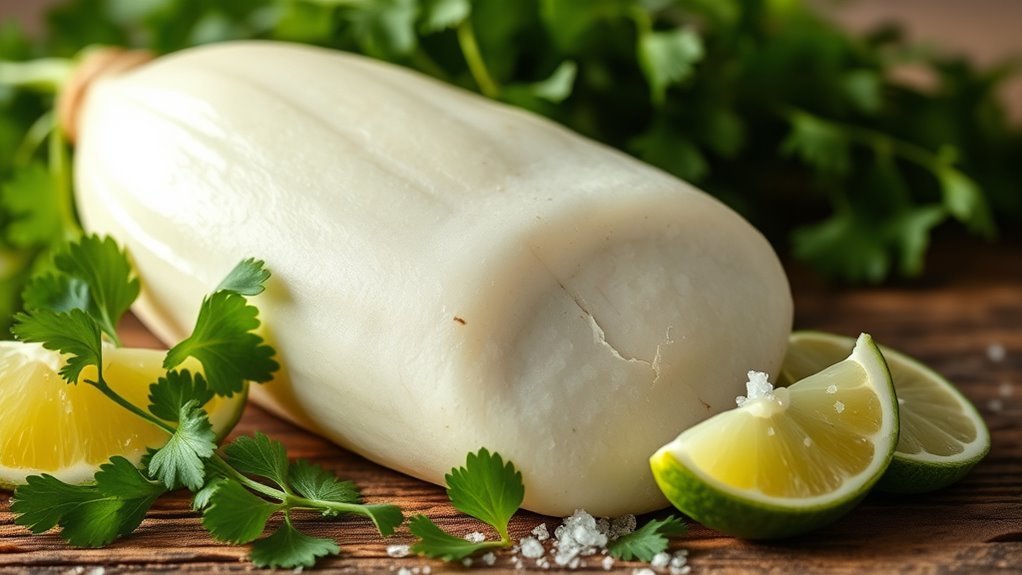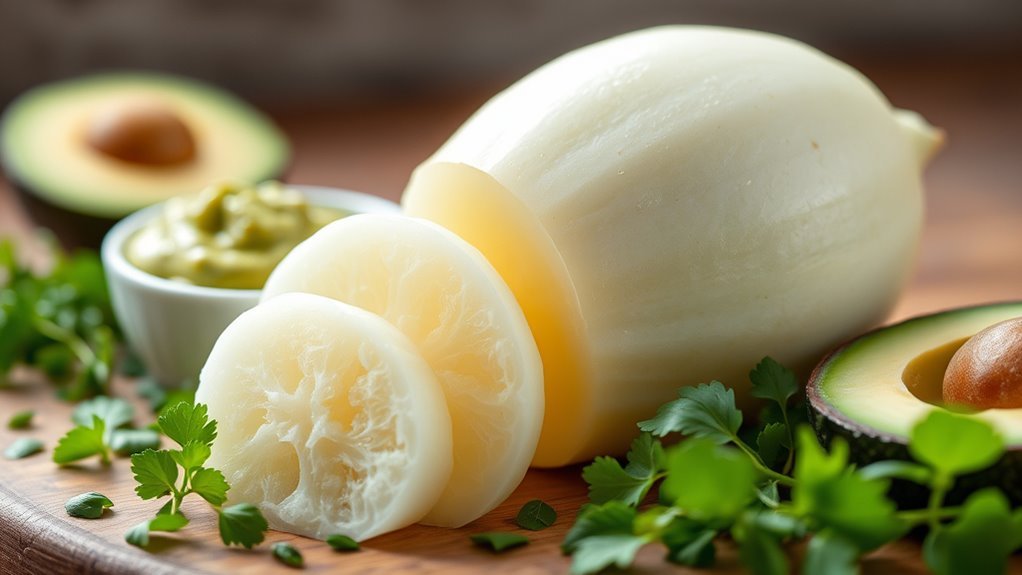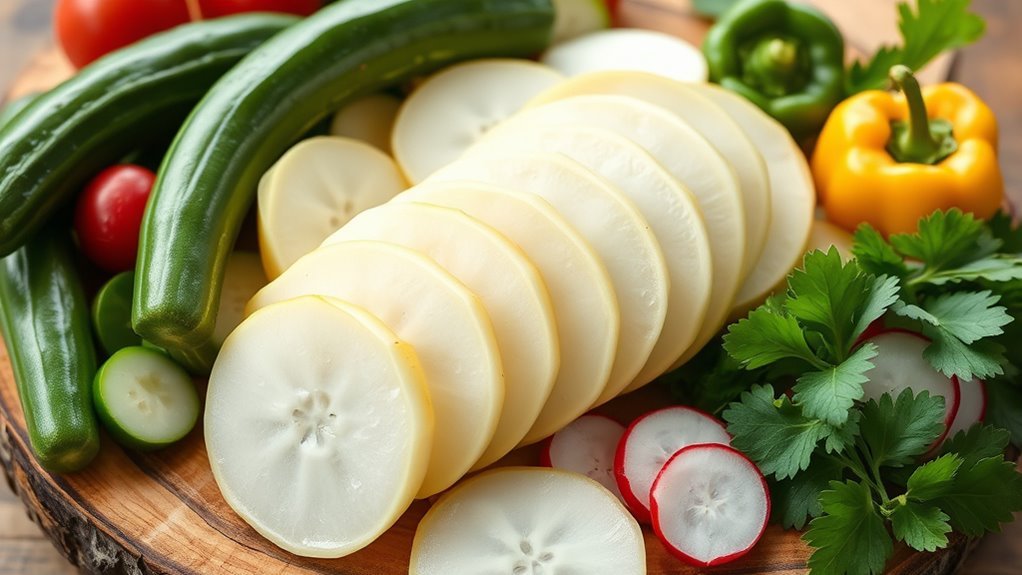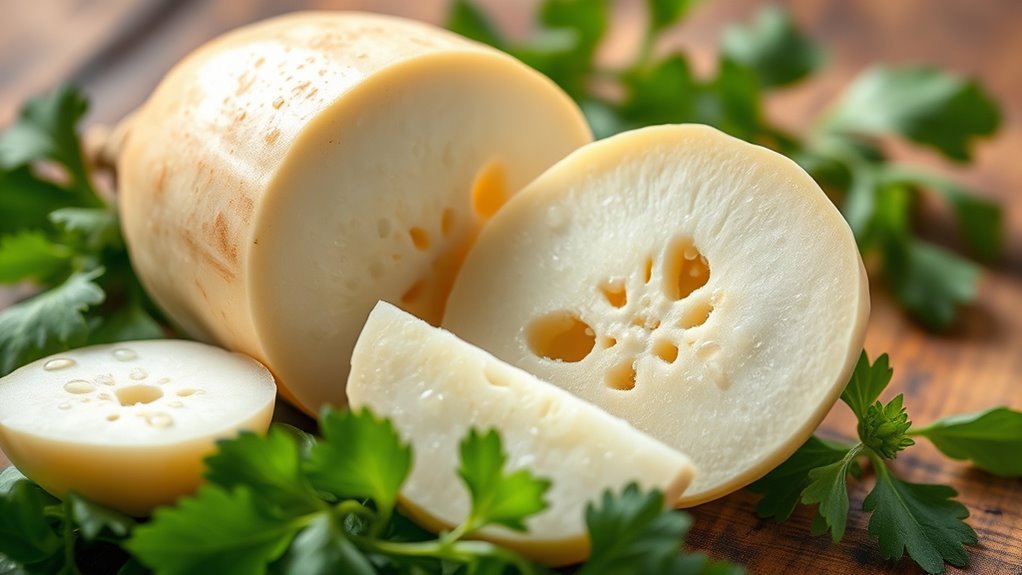Yes, jicama can be keto-friendly. It contains around 4.7 net carbs per 100g, thanks to its high fiber content. This low-calorie root vegetable is also rich in vitamin C and potassium, making it a nutritious choice for your meals. While it offers a crunchy texture and unique flavor, moderation is key, especially for strict keto dieters. Curious about how to incorporate jicama or its health benefits? There’s more to discover about this versatile vegetable!
Nutritional Profile of Jicama

When you consider incorporating jicama into your diet, it’s essential to understand its nutritional profile. Originating from Mexico, this root vegetable is not only crunchy and invigorating but also packed with jicama benefits. It’s low in calories and high in fiber, making it an excellent choice for those seeking to maintain a healthy weight. Jicama is rich in vitamin C, which supports immune function, and it contains potassium, essential for heart health. Additionally, its high water content can contribute to hydration. By enjoying jicama in salads or as a snack, you can savor its unique taste while reaping its health benefits. Understanding these aspects of jicama can empower you to make informed dietary choices.
Carbohydrate Content in Jicama

Although jicama is often celebrated for its health benefits, its carbohydrate content is an important factor to take into account, especially for those following a ketogenic diet. One cup of jicama contains approximately 12 grams of carbohydrates, including about 6 grams of fiber, which means the net carbs are around 6 grams. While this makes jicama a relatively low-carb option, it’s vital to reflect on how it fits into your overall daily carb intake. If you’re looking for jicama alternatives, options like cauliflower or zucchini may be better suited for strict keto adherence. Balancing jicama’s unique benefits with its carb content can help you enjoy its crisp texture while staying aligned with your dietary goals.
Comparing Jicama to Other Low-Carb Vegetables

When comparing jicama to other low-carb vegetables, it’s essential to look at their nutritional profiles and carbohydrate content. Jicama stands out for its fiber and water content, but how does it stack up against options like zucchini or cauliflower with regard to culinary versatility? Understanding these differences can help you make informed choices for your keto diet.
Nutritional Profile Overview
While many vegetables are celebrated for their low-carb content, jicama stands out due to its unique nutritional profile. It’s rich in fiber and vitamin C, which can enhance your immune system and promote digestive health. Compared to other low-carb vegetables like cauliflower and zucchini, jicama offers a revitalizing crunch and a slightly sweet flavor, making it a versatile addition to your meals. You can enjoy jicama in salads, as a raw snack, or even spiralized as a low-carb alternative to pasta. The jicama health benefits extend to its low-calorie count, allowing you to indulge without guilt. Experiment with various jicama serving suggestions to find what you love most in your keto-friendly diet.
Carbohydrate Content Comparison
Jicama’s appeal goes beyond its nutritional benefits; its carbohydrate content makes it particularly interesting for those following a keto diet. With about 5 grams of carbs per 100 grams, jicama is a fantastic choice compared to other low-carb vegetables like cucumber, which has around 4 grams, or zucchini at about 3 grams. When considering jicama alternatives, keep in mind the balance of carbs versus fiber. Jicama offers a unique crunch and can be a satisfying addition to your low carb snacks. While options like radishes and celery are also low in carbs, they can’t quite match jicama’s sweet flavor and texture. So, if you’re looking for variety, jicama could be your go-to choice for maintaining a keto lifestyle.
Culinary Uses and Versatility
Although many low-carb vegetables offer unique flavors and textures, jicama stands out for its versatility in the kitchen. You can enjoy jicama in numerous ways, making it a fantastic addition to your meals. For fresh options, consider jicama salads or crunchy jicama slaws that add a revitalizing twist. If you’re craving something more substantial, jicama wraps and jicama stir fries can serve as great substitutes for higher-carb ingredients. For snacking, try jicama chips or jicama snacks paired with flavorful jicama dips. Additionally, jicama garnishes can elevate any dish, showcasing its adaptability. By incorporating jicama into your diet, you’re not just enjoying a low-carb vegetable; you’re revealing a world of culinary possibilities.
Health Benefits of Jicama
When you’re looking for a nutritious addition to your diet, jicama offers a range of health benefits that can enhance your overall well-being. This crunchy root vegetable is low in calories and high in fiber, making it an excellent choice for maintaining a healthy weight. Jicama nutrition is also impressive, providing essential vitamins like C and minerals like potassium, which support your immune system and heart health.
Here’s a quick overview of jicama benefits:
| Nutrient | Amount per 100g | Benefit |
|---|---|---|
| Calories | 38 | Low-calorie snack |
| Fiber | 4.9g | Aids digestion |
| Vitamin C | 20mg | Boosts immunity |
| Potassium | 429mg | Supports heart health |
Incorporating jicama into your meals can be an invigorating and health-conscious decision.
How to Incorporate Jicama Into Your Keto Diet
If you’re looking for a versatile vegetable to include in your keto diet, jicama can be an excellent choice. It’s low in carbs and high in fiber, making it perfect for satisfying your hunger without derailing your macros. You can easily use jicama to create crunchy jicama snacks by slicing it into sticks or chips and pairing it with your favorite keto-friendly dips, like guacamole or ranch dressing. Additionally, jicama salads are a revitalizing option; toss diced jicama with avocado, cucumber, and your choice of protein for a nutrient-packed meal. Its mild flavor allows it to absorb seasonings well, so don’t hesitate to get creative. Enjoy the freedom of incorporating jicama into your meals while staying on track with your keto goals!
Jicama Recipes for Keto Dieters
Since jicama is low in carbohydrates and rich in fiber, it’s a fantastic ingredient for keto dieters looking to add variety to their meals. One delicious option is jicama slaw, which combines shredded jicama with shredded cabbage, carrots, and a tangy dressing for a revitalizing side dish. You can also experiment with jicama fries; simply cut jicama into sticks, season with your favorite spices, and bake or air-fry until crispy. These dishes not only satisfy your cravings but also keep you within your carb limits. By incorporating jicama into your meal prep, you’re adding a crunchy, nutritious element that enhances your keto experience. Enjoy the freedom to create tasty meals while staying on track with your diet!
Potential Drawbacks of Eating Jicama on Keto
While jicama can be a crunchy, low-calorie snack, its carb content may raise concerns for strict keto dieters. Additionally, some people experience digestive reactions, such as bloating or gas, when consuming jicama. It’s important to take into account these potential drawbacks when incorporating this vegetable into your keto meal plan.
Carb Content Concerns
Although jicama is often praised for its low calorie and high fiber content, its carbohydrate levels can raise concerns for those on a strict keto diet. With around 11 grams of carbs per 100 grams, consuming jicama might hinder your ability to maintain ketosis. While it offers several jicama benefits, such as promoting hydration and providing antioxidants, you may want to reflect on keto alternatives like cauliflower or zucchini that contain fewer carbs. If you’re looking to enjoy the crunch and texture of jicama without exceeding your carb limit, moderation is key. Stay informed and weigh your options carefully to make the best choices for your keto lifestyle while enjoying the freedom of food diversity.
Digestive Reactions Possible
If you’re considering adding jicama to your keto diet, be aware that it can cause digestive reactions in some individuals. Jicama is high in fiber, which can lead to bloating and gas, especially if your body isn’t used to it. The fiber effects can vary, so it’s wise to start with small portions. Additionally, jicama contains resistant starch, which may require specific digestive enzymes to break down. For some, this can be a challenge, leading to discomfort. If you have a sensitive digestive system, monitoring your body’s response to jicama is vital. While it offers health benefits, it’s essential to balance those against any potential digestive issues you may experience on keto.
Understanding Net Carbs and Fiber in Jicama
Understanding the net carbs and fiber content in jicama is essential for anyone following a keto diet. Jicama is a low-calorie root vegetable that provides a satisfying crunch and a unique flavor. Its fiber content plays a significant role in calculating net carbs, which is the total carbohydrates minus fiber. Here’s a quick breakdown:
| Nutrient | Amount per 100g |
|---|---|
| Total Carbs | 9.6g |
| Fiber | 4.9g |
| Net Carbs | 4.7g |
With just 4.7g of net carbs per 100g, jicama can be a great addition to your keto-friendly meals. Enjoying jicama in moderation helps you stay within your carb limits while benefiting from its fiber content.
Jicama vs. Other Common Keto Vegetables
When comparing jicama to other common keto-friendly vegetables, it’s important to look at the nutritional profiles and carb content. Jicama offers a unique balance of fiber and low net carbs, making it a viable option for your keto diet. By analyzing these factors, you can better decide how jicama stacks up against alternatives like zucchini or cauliflower.
Nutritional Comparison Overview
Jicama offers a unique nutritional profile compared to other common keto vegetables, making it an intriguing option for those following a low-carb diet. This root vegetable is low in calories and high in fiber, providing significant nutritional benefits. Unlike leafy greens, jicama boasts a crunchy texture and a slightly sweet flavor, which can add variety to your meals.
For serving suggestions, try it raw in salads or as a dipper for guacamole. When compared to cauliflower or zucchini, jicama contains different vitamins and minerals, like vitamin C and potassium. This diversity can enhance your nutrient intake while keeping your meals interesting. Ultimately, incorporating jicama into your keto plan can be a delicious way to enjoy healthy eating.
Carb Content Analysis
With just 6 grams of net carbs per 100-gram serving, jicama stands out among common keto vegetables. Its low carb content, coupled with its crunchy texture, makes it a great alternative for those following a ketogenic diet. When you compare jicama to other popular options, you can see how it measures up:
| Vegetable | Net Carbs (per 100g) |
|---|---|
| Jicama | 6g |
| Cauliflower | 3g |
| Zucchini | 3g |
Different jicama varieties may offer slight variations in nutritional content, but they generally maintain a low carb profile. Understanding these health implications can help you make informed choices, ensuring your keto journey is both enjoyable and sustainable.
Final Thoughts on Jicama and the Keto Lifestyle
Although many people seek to maintain a low-carb diet, incorporating jicama into your meals can be both enjoyable and beneficial. This versatile root vegetable offers jicama benefits, including a low glycemic index and high fiber content, making it a fantastic keto alternative to starchy vegetables. You can easily add jicama to salads, stir-fries, or enjoy it raw with your favorite dip, satisfying your cravings without derailing your diet. Plus, its crunchy texture and subtle sweetness can enhance various dishes, allowing you the freedom to experiment in the kitchen. Remember, while jicama is a great option, it’s important to balance it with other keto-friendly foods. Embracing variety will keep your meals exciting and aligned with your health goals.


